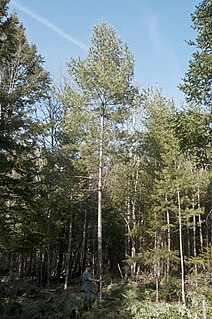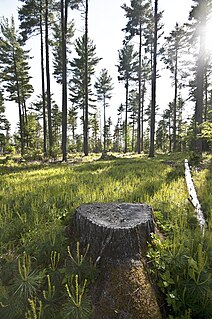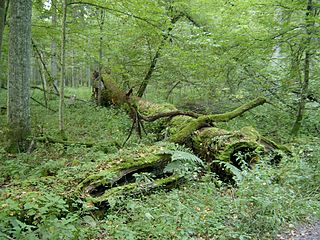
Logging is the cutting, skidding, on-site processing, and loading of trees or logs onto trucks or skeleton cars.

Coppicing is a traditional method of woodland management which exploits the capacity of many species of trees to put out new shoots from their stump or roots if cut down. In a coppiced wood, which is called a copse, young tree stems are repeatedly cut down to near ground level, known as a stool. New growth emerges and after a number of years, the coppiced tree is harvested and the cycle begins anew. Pollarding is a similar process carried out at a higher level on the tree.

Harvesting is the process of gathering a ripe crop from the fields. Reaping is the cutting of grain or pulse for harvest, typically using a scythe, sickle, or reaper. On smaller farms with minimal mechanization, harvesting is the most labor-intensive activity of the growing season. On large mechanized farms, harvesting utilizes the most expensive and sophisticated farm machinery, such as the combine harvester. Process automation has increased the efficiency of both the seeding and harvesting process. Specialized harvesting equipment utilizing conveyor belts to mimic gentle gripping and mass transport replaces the manual task of removing each seedling by hand. The term "harvesting" in general usage may include immediate postharvest handling, including cleaning, sorting, packing, and cooling.

Thinning is a term used in agricultural sciences to mean the removal of some plants, or parts of plants, to make room for the growth of others. Selective removal of parts of a plant such as branches, buds, or roots is typically known as pruning.

Silviculture is the practice of controlling the growth, composition, health, and quality of forests to meet diverse needs and values.

Clearcutting, clearfelling or clearcut logging is a forestry/logging practice in which most or all trees in an area are uniformly cut down. Along with shelterwood and seed tree harvests, it is used by foresters to create certain types of forest ecosystems and to promote select species that require an abundance of sunlight or grow in large, even-age stands. Logging companies and forest-worker unions in some countries support the practice for scientific, safety and economic reasons, while detractors consider it a form of deforestation that destroys natural habitats and contributes to climate change.
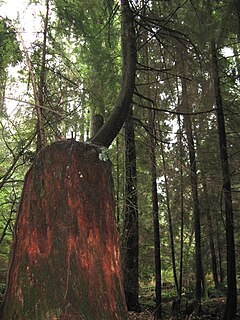
A secondary forest is a forest or woodland area which has re-grown after a timber harvest, until a long enough period has passed so that the effects of the disturbance are no longer evident. It is distinguished from an old-growth forest, which has not recently undergone such disruption, and complex early seral forest, as well as third-growth forests that result from harvest in second growth forests. Secondary forest regrowing after timber harvest differs from forest regrowing after natural disturbances such as fire, insect infestation, or windthrow because the dead trees remain to provide nutrients, structure, and water retention after natural disturbances. However, often after natural disturbance the timber is harvested and removed from the system, in which case the system more closely resembles secondary forest rather than complex early seral forest.

After a tree has been cut and felled, the stump or tree stump is usually a small remaining portion of the trunk with the roots still in the ground. Stumps may show the age-defining rings of a tree. The study of these rings is known as dendrochronology.
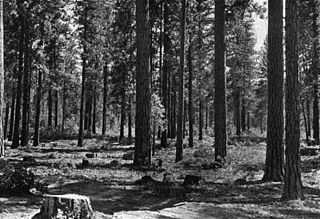
Selection cutting, also known as selective cutting, is the silvicultural practice of harvesting trees in a way that moves a forest stand towards an uneven-aged or all-aged condition, or 'structure'. Using stocking models derived from the study of old growth forests, '"Selection cutting"', also known as 'selection system', or 'selection silviculture', manages the establishment, continued growth and final harvest of multiple age classes of trees within a stand. A closely related approach to forest management is Continuous Cover Forestry (CCF), which makes use of selection systems to achieve a permanently irregular stand structure.
Management of Pacific Northwest riparian forests is necessary because many of these forests have been dramatically changed from their original makeup. The primary interest in riparian forest and aquatic ecosystems under the Northwest Forest Plan (NWFP) is the need to restore stream habitat for fish populations, particularly Anadromous salmonids. Some of these forests have been grazed by cattle or other livestock. The heavy hooves of these animals compact the soil. This compaction doesn’t allow the water to be absorbed into the ground, so the water runs off into the stream carrying top soil along the way.
Patch cuts are logging cuts too small to be considered clearcuts, and are instead considered a form of selection cut. A typical patch cut might be 2-3 tree lengths. Below a certain size, seedling regeneration advantage shifts from the shade intolerant species favored in clearcuts to the shade tolerant species favored by selection harvests.
The following outline is provided as an overview of and guide to forestry:
Variable retention is a relatively new silvicultural system that retains forest structural elements for at least one rotation in order to preserve environmental values associated with structurally complex forests.

Swanton Pacific Ranch is a 3,200-acre (13 km2) ranch in Santa Cruz County, California, outside the town of Davenport. The ranch is owned and operated by California Polytechnic State University for educational and research in sustainable agriculture. The ranch encompasses rangeland, livestock, and forestry operations for the College of Agriculture, Food and Environmental Sciences and comprises a significant part of the community of Swanton.
Even-aged timber management is a group of forest management practices employed to achieve a nearly coeval cohort group of forest trees. The practice of even-aged management is often pursued to minimize costs to loggers. In some cases, the practices of even aged timber management are frequently implicated in biodiversity loss and other ecological damage. Even-aged timber management can also be beneficial to restoring natural native species succession.
Selective logging or partial forest removal is the practice of cutting down one or two species of trees while leaving the rest intact. Selective logging is often considered a better alternative to clear cutting in which a large area of a forest is cut down, leaving little behind except wood debris and a deforested landscape. Selective logging in the Brazilian Amazon was recently shown in analyses of Landsat Enhanced Thematic Mapper Plus data at high spatial resolution to be occurring at rates of about 12,000–20,000 km2 per year, thus indicating the central role of selective logging in tropical forest disturbance. Although selective logging has a far less impact on forest processes than deforestation, selectively logged sites experience higher rates of forest fires, tree fall, changes in microclimate, soil compaction and erosion, among other ecological impacts on biodiversity and ecosystem functioning.
In forestry and silviculture, a sanitation harvest or sanitation cutting is a harvest of trees for the purpose of removing insects or diseases from a stand of trees. Sanitation harvesting is used to prevent the diseases or pests from spreading to other nearby trees. It is a form of intermediate management and is used in order to improve an already existing stand of trees.
When logging began in British Columbia, Canada, in the late 19th century, the overriding concern was to harvest timber in the most economical fashion. Reforestation, aesthetics and protection of fish and wildlife habitat were not issues of great concern.
